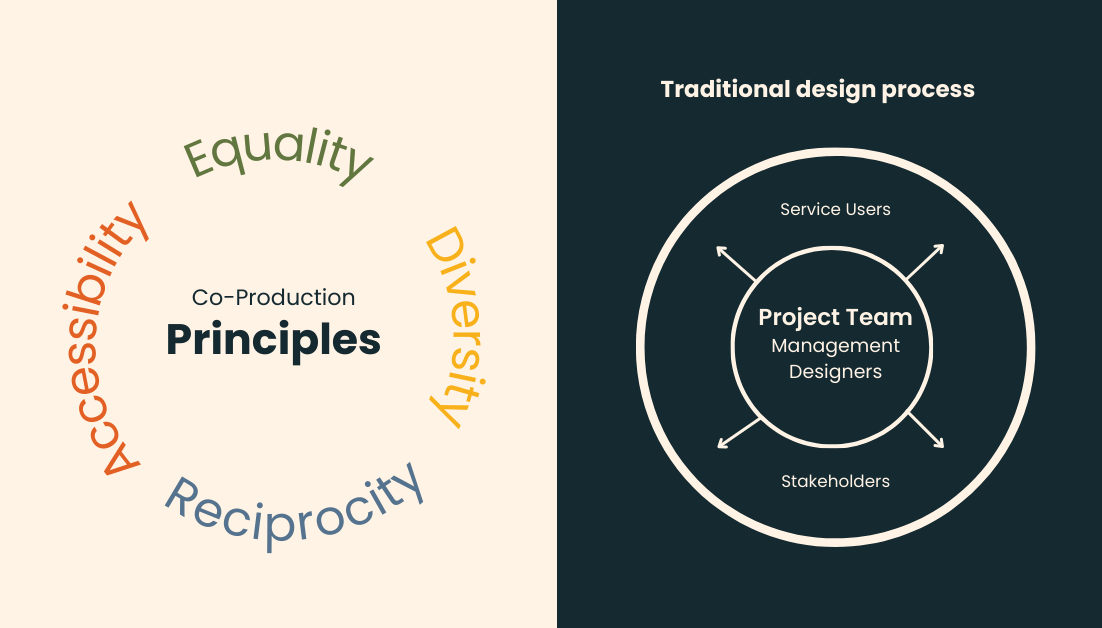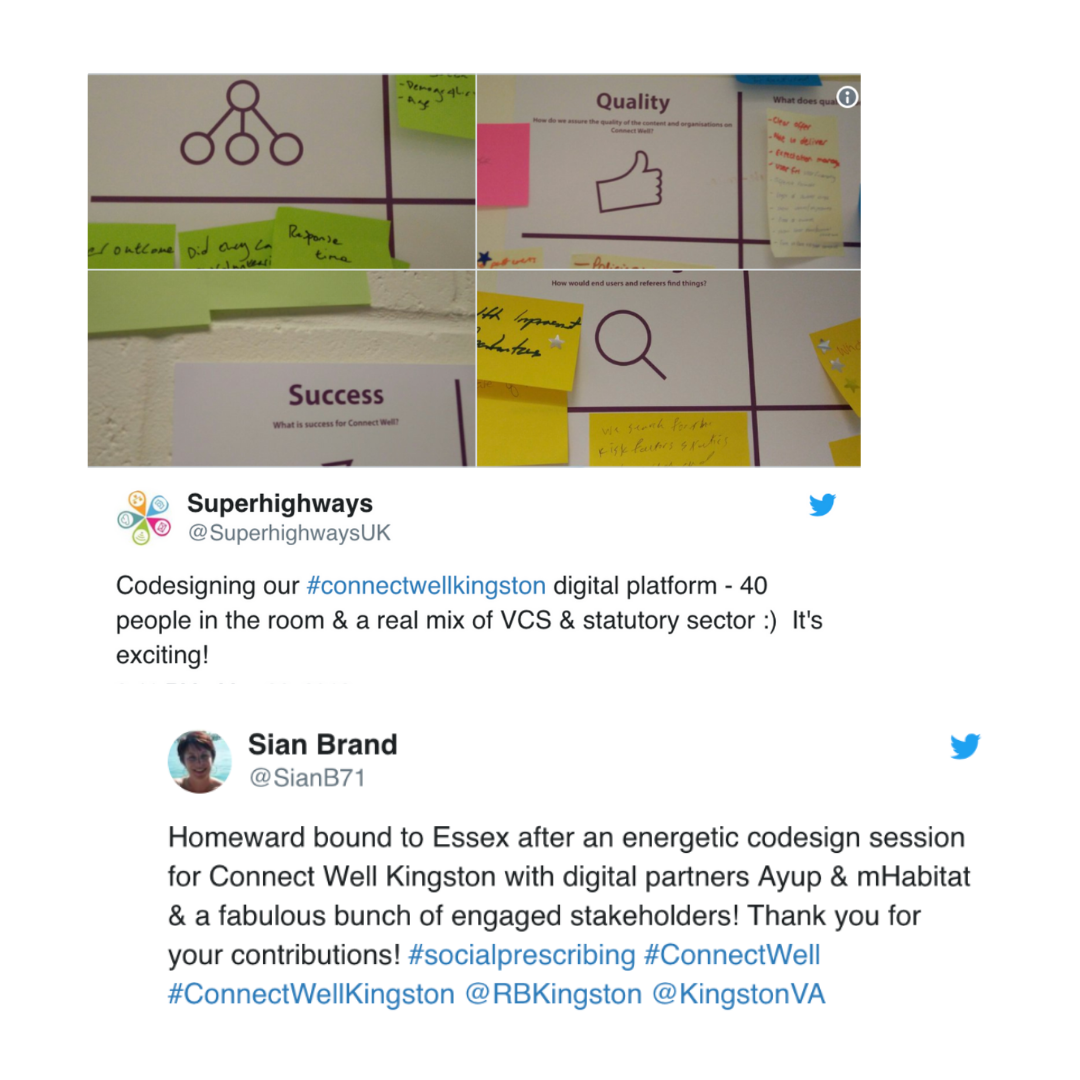What is co-production?
You might have come across the phrase co-design or co-production. Maybe you've had the opportunity to use one of these ways of working in the role that you're currently in, or perhaps your involvement has been within a digital service setting - creating or shaping digital products.
Whatever your experience with co-production, you'll have no doubt heard the phrase a lot over the last few years because it's a key concept in the development of public services within adult social care. We’re looking at co-production purely from a digital perspective, but the following quote offers a nice summary of what the term means:
“We spend a lot of time designing the bridge, but not enough time thinking about the people who are crossing it.”
- Dr. Prabhjot Singh, Director of Systems Design at the Earth Institute
How does this quote relate to design and build? A traditional top-down design approach can be said to be focused too much on the things that we're designing and not enough on the people who are using it.
On the other hand, user-centred design and user-centric production are all about spending more time thinking about the people and the stakeholders involved, and how they're going to be affected by the thing that we are designing.
By taking the latter approach, we’re going to design something that's got the best chance of working and has a more positive impact.
For a more in-depth (and fun!) explainer on co-production, take a look at this video, "The Parable of Blobs and Squares" by James Mackie.
So you may very well be aware of the co-production in the adult social care and the Care Act sense, and we'll be looking at applying those similar sorts of principles to designing and producing digital services.
Co-production means working together in equal partnership for equal benefit. It brings together experiences, knowledge and understanding from people’s personal and professional lives, for better outcomes and mutual benefit.
It's all about putting people first, so designing with them instead of to them, and bringing together individuals and groups of people to influence the way that services and products are designed, commissioned, and delivered.
Putting people first helps to create that feeling of empowerment and shifts from the top-down approach to designing products and services.
Core principles of co-production
- Equality - giving everyone a voice and an opportunity to engage in the work
- Diversity - ensuring the end result is representative of the community, users, and stakeholders
- Accessibility - making services accessible for all by default
- Reciprocity - an exchange of information, knowledge, time. Making sure that people who give their time are gaining something in return
Limitations of the traditional design process
On the flip side, the traditional design process is almost the opposite of the co-production approach. This would involve designing from the inside out, more often than not thinking about this big solution that's going to solve a problem, but not spending a huge amount of time thinking about the end users.
It's more of a linear process, often hinging on the “HIPPO”, which is the "highest paid person's opinion". Whoever's at the top of that hierarchy is making those decisions and pushing that down, whereas co-production and that user-centred approach is much more grassroots, bottom up.

The benefits of co-production
By implementing co-production into projects, you can draw some of the benefits. What are they?
Less waste - you’re building something that's needed and is fit for purpose.
Evidence-based - the production is user-led and is hyper-focussed around their specific needs and feedback, offering learning opportunities. You have a better understanding of the users throughout that process, which is an incredibly valuable attribute to maintain throughout the project.
Promotes collaboration - co-production brings people together and breaks down silos, offering greater alignment between individuals. It helps build strong foundations, which has been particularly important in our case, as we help councils and communities to build community assets.
Create champions - As a result of the work, you come away with engaged stakeholders, advocating for the digital services that you’re building.
More agile - If you have a continuous feedback loop; asking for opinions and involving people in those decisions, you’re able to figure out problems and build things better, quicker and faster, and see whether things are working or not.
Building trust - listening to the community's opinion allows you to build stronger relationships. You can see some of the feedback that we got from some codesign workshops that we did from actual attendees below. Being asked about what their opinions and needs were mattered, and this is empowering to users and stakeholders.

Drawbacks of co-production
Of course, it's not always easy to implement co-design and co-production, especially when you think about those principles previously mentioned.
Activity around equality and reciprocity can be challenging at times, time-consuming, and resource-intensive to gather a true representation from all stakeholders.
If you do get that true representation, it can then be difficult and complex to manage the conflicting opinions and needs that will inevitably arise when engaging with a wide range of audiences.
On top of that, the ideal solution your cohort comes up with might not even be possible or isn’t everybody's ideal solution.
There's always compromise, but by using co-production principles you can create a level of understanding that isn't necessarily there in that traditional design process. Actively engaging people in the discussions around decision making and balancing the different needs and opinions further enhances some of the benefits of this approach.
So, whilst there are challenges, there are tools and frameworks that can help you work through them.
How to do co-production
So how do you approach co-production when designing digital services? The Social Care Institute for Excellence (SCIE) has some great resources, including videos all around co-production and prevention, reduction, and delay.
They've come up with four key themes to think about when doing co-production, and they are culture, structure, practice, and review. Let’s look at each one of those but through the lens of digital services and co-production.
Culture - Activities like Team Canvas can help bring a diverse group of people together to agree on vision, values, purpose, and goals. This allows the collective to come up with principles that will guide the work.
Structure - Tools such as Stakeholder Mapping can help identify the right people to be involved from the start. Are you engaging with all of the voices you need? Some of those people may need more of your attention or less. Using a system of tools, activities, and resources can help get all your ducks in a row.
Practice - This is all about making sure that everyone involved in co-production has enough information to be able to engage in that process. Ask yourself if you’re doing the right activities with the right people. That way you can build up those relationships that are needed to create trust and confidence.
Review - Making sure that any co-production activity is not one-off. Think about how periods of collaboration can be put into that phase of delivery, and also knowing who needs to do what.
These four areas can be applied both to greenfield projects (fresh projects that haven't been done before), and also to off-the-shelf solutions that are already configured, where you can still use co-production to shape what you have in place.
Co-production tools
Some of our go-to activities and resources that we use to kick start the co-production process might include things like:
- Prototyping
- Roles & responsibilities
- Toddler-Grandparent Conversation
- Rapid 8s
- Team Canvas
- Stakeholder Mapping
- Community asset mapping
- User persona templates
- S.C.A.M.P.E.R
- Empathy mapping
- Yes, and...
- Invitation letter
- Wall of frustration / pain points
- Check-in / check-out
- Safe space
- Card sorting
- Day in the life
- Storyboarding
- User needs statements
- Consent form
- Dot voting
- Retrospectives / debriefing with teams
There are hundreds and hundreds of different tools, frameworks, and templates that you could use, but this is just a snapshot of the ones that we dip into regularly.
How does co-production support adult social care?
We found that over the last few years, co-production has helped us as a company to build digital services that support a prevent, reduce and delay strategy. It's allowed people to access assets in their community, helped build resilience, and encouraged independence.
How has it done this? Co-production gave us a greater understanding of all of the perspectives in the communities, residents, and services alike. It's helped us to test real user needs through tools like user stories and personas and prototyping, and build trust with our stakeholders.
Tools like stakeholder mapping allow us to create bonds with communities, contributing to a digital service that’s evidence-based and fit for purpose.
Activities such as “day in the life” can be useful in exploring and validating user needs.
It's helped us to get buy-in on the creation of a community asset.
We want our local platforms to be a long-term community asset and involving people in the process means we get buy-in at the early stages from those who will be using them. Tools such as Team Canvas help us lay the foundation to do that work.
This approach means that the councils we work with really benefit from the strengths and assets of the local community, which is why it’s something we’ve continued to do and advocate. None of the benefits we see from our localised platforms, the signposting, ease of use and community look and feel would be possible without the co-production approach that’s embedded in how we’ve worked since first producing the open source platform, Ayup Connect, in 2018.
If you'd like to know more about what we're offering, then we're doing some free training sessions around co-production to help you and your team get the ball rolling, which you can book with us today.
